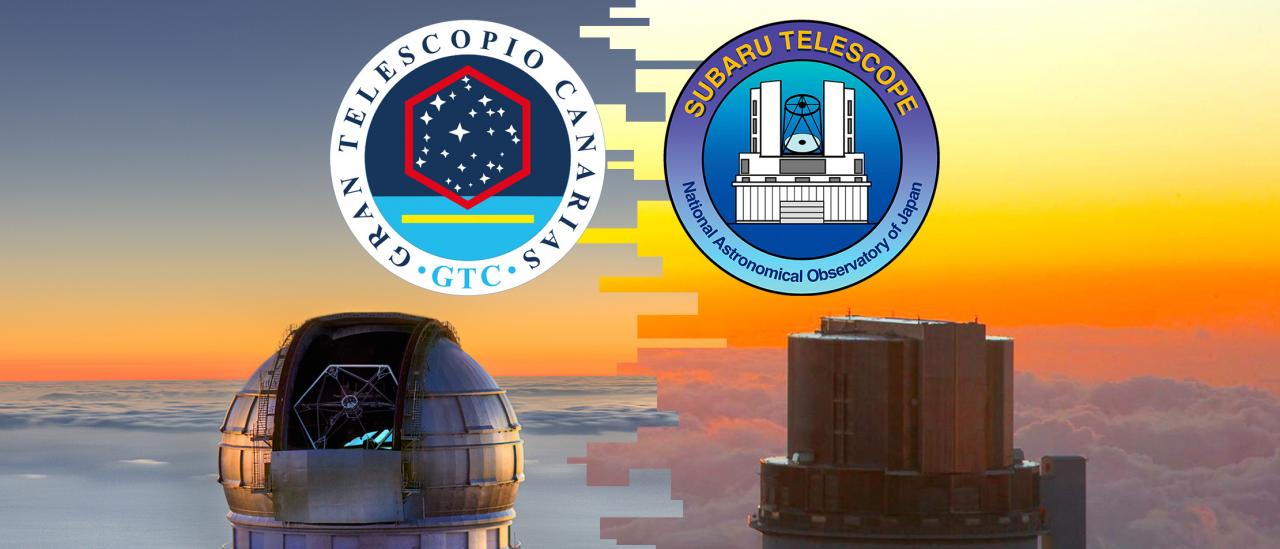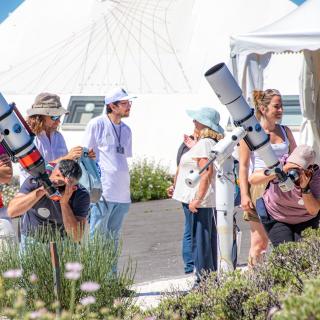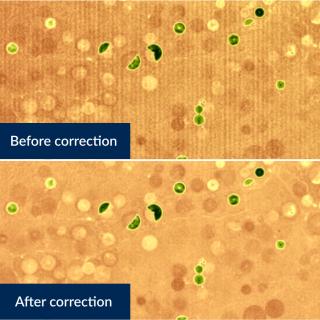A team led by researchers from the Instituto de Astrofísica de Canarias (IAC) and the National Astronomical Observatory of Japan (NAOJ) has made, with the Gran Telescopio Canarias (GTC or Grantecan) and the Subaru telescope, the largest and deepest follow-up to date of a black hole collision previously detected in gravitational waves. The observations showed no optical signal in the direction of the phenomenon, which means that if this black hole merger emitted any light at all, it was fainter than the detection limit of these two telescopes and their instruments. This result imposes an observational limit on the detection of electromagnetic emission from such events.
Since the first direct detection of gravitational waves with LIGO in 2015, gravitational wave astronomy has attracted much attention of the astronomers all over the world. In 2017, the gravitational wave event from the binary neutron star merger GW170817 was detected; this event was the first and only gravitational wave event for which the electromagnetic counterpart has been firmly detected so far.
Gravitational wave telescopes detect not only gravitational waves from binary neutron star coalescences, but also from black hole-neutron star coalescences and binary black hole mergers. Indeed, the number of gravitational wave events from binary black hole coalescences exceeds 90% of the entire gravitational wave detections so far.
Due to the strong gravity field, even light cannot escape from a black hole , and thus it is naively not expected that binary black hole coalescences are accompanied by electromagnetic emission. However, the detection of an electromagnetic emission was claimed for the gravitational wave event GW190521 from a binary black hole coalescence. Multiple mechanisms for the emission of electromagnetic emission have been theoretically proposed, but the scientific community is still not entirely sure.
Therefore, the multi-frecuency follow-up observations are important to clarify whether binary black hole coalescences are accompanied by electromagnetic emission, and, if so, how bright they are. Josefa Becerra González responsible for this research at IAC said “Even though the theoretical framework for the electromagnetic emission of binary black holes mergers is still under discussion, the obervations are crucial to probe the different possibilities”.
On 24 February 2020, LIGO and Virgo detected the gravitational wave from a binary black hole coalescence named GW200224_222234. The research team led by Dr. Takayuki Ohgami at the NAOJ and Dr. Josefa Becerra González at the IAC performed follow-up observations of GW200224_222234 with the Subaru Telescope/Hyper Suprime-Cam (HSC) and the Gran Telescopio CANARIAS/Optical System for Imaging and low-Intermediate-Resolution Integrated Spectroscopy (OSIRIS).
Tomoki Morokuma at Chiba Institute of Technology, the Co-Principal Investigators of the GTC-Subaru Collaboration, said, “The cooperation of Subaru and GTC telescopes provide us with a very unique synergy to perform deep and wide photometric follow up observations with Subaru together with the powerful spectroscopic capabilities provided by GTC. This collaboration offers a key opportunity to reveal the nature of the possible electromagnetic radiation from binary black hole mergers for the first time.”
Gravitational-wave detectors usually have a large margin of error. The accuracy in the direction of arrival of the signal is typically about 500 square degrees (about 2 000 full moons). However, the positional error of GW200224_2222234 was about 10 times smaller due to its strong emission, covering about 50 square degrees (200 full moons).
The research team started a deep search for an electromagnetic counterpart of GW200224_2222234 and succeeded in observing almost the entire (91%) arrival direction of the signal just 12 hours after the detection of the gravitational wave event. This is the first achievement of deep follow-up for a binary black hole coalescence covering more than 90% of the arrival direction.
The team found 22 transient sources, i.e. objects whose emission occurs only for a certain time, other than supernovae (a type of transient event that occurs at the end of the life of stars), with the transient survey with HSC and carried out spectroscopic follow-up observations of 5 of them with OSIRIS at GTC to measure the distances to their host galaxies.
Nozomu Tominaga at the National Astronomical Observatory of Japan says: "Using the Subaru Telescope and GTC, we could make an unprecedented wide and deep follow up of a gravitational wave event from a binary black hole coalescence, but we detect no obvious electromagnetic counterpart. We need to continue follow ups of the gravitational waves from binary black hole coalescences to search for firm electromagnetic emission and study their diversity."
Gravitational wave observations will resume in May 2023 with a total of four gravitational wave detectors, LIGO, Virgo and KAGRA. With their improved performance, they will detect more gravitational wave events from binary neutron star coalescence and binary black hole coalescence. The research team will continue with follow-up observations using the Subaru Telescope and GTC to to unravel the mystery of electromagnetic emission in black hole collisions and reveal the diversity of gravitational wave events.
Artículo: Takayuki Ohgami, Josefa Becerra Gonzalez et al. "Follow-up survey for the binary black hole merger GW200224_222234 using Subaru/HSC and GTC/OSIRIS", The Astrophysical Journal, 947 9. DOI: 10.3847/1538-4357/acbd42
Contacto en el IAC:
Josefa Becerra González, josefa.becerra.gonzalez [at] iac.es (josefa[dot]becerra[dot]gonzalez[at]iac[dot]es)




